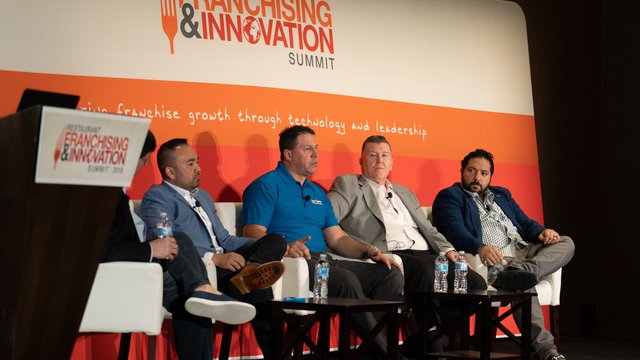
Third-party delivery has become the most disruptive force in the restaurant industry today, as the growth of these services has created both an opportunity and a serious source of competition for restaurants. Delivery orders now comprise a significant portion of sales for many restaurants, while some independent delivery services have morphed into “virtual restaurants.”
“We have to be in the delivery business,” said Sammy Aldeeb, CEO of Urban Bricks, during a panel at the Restaurant Franchising & Innovation Summit in Louisville titled, “The delivery conundrum: keep it in-house or take it outside?”
Aldeeb said foot traffic is down in restaurants since more customers are opting for delivery.
“It’s a way to get our food into peoples’ mouths,” agreed panelist Alonso Castaneda, vice president of brand development and strategy at Four Foods Group, a multi-brand restaurant operator, who has seen customers pay a $3 delivery charge for a $4 beverage.
“I think people have gotten inherently lazy,” said panelist Patrick Conlin, president of Jake’s Franchising LLC/Wayback Burgers.
Challenges and opportunities
Panel moderator Scott Absher, co-founder and CEO of Shiftpixy, a technology provider that helps restaurants address human capital issues, said third-party delivery has delivered 20 to 40 percent growth for restaurants, but at the same time, it has compromised brand reputation for some companies because of poor quality service. Hence, the toughest decision brands are facing is to contract third-party delivery or provide their own in-house delivery service.
While in-house delivery is an option, brands that go this route find the available labor pool limited, thanks in large measure to the growth of third-party services. So noticed panelist Matt Friedman, co-founder and CEO of Wing Zone, which uses both third-party services and an in-house service.
“We’re kind of battling this,” said Friedman, whose company’s dine-in business is now less than 10 percent of the total revenue. “We always believed that controlling (guest) experience is a better experience.”
Asked if he provides his delivery drivers the vehicles, Friedman said he does not, since restaurants that tried to do this encountered logistics problems. In addition, the insurance is very expensive.
The profitability challenge
Whether using third-party services or an in-house service, delivery adds an extra cost and can hurt profitability.
Castaneda, whose company allows franchisees the option of charging extra for delivery, said he doesn’t see how a restaurant cannot charge extra and maintain their necessary margin. Eighty percent of his franchisees charge for delivery, he said.
Friedman, who said third-party delivery represents more than 20 percent of the business, explained that profit margins can be challenging when using these services. At the same time, he said, operating in-house delivery has its own challenges.
“The supply of drivers is very, very challenging,” Friedman said.
He said he is paying the driver the full delivery charge in some markets. The cost per delivery is between $3 and $10, he said, depending on the volume and the local labor market.
Another consideration, according to Friedman, is that the third-party services have better driver tracking software than what his own company has.
The panelists agreed that it’s important to negotiate contract terms with third-party services. Most delivery services, Uber Eats being an exception, will negotiate terms.
“Negotiate the heck out of everything you do,” Friedman said. “Just pound them for every percentage possible.”
Operational issues
The panelist agreed that one downside of using third-party services for restaurants is that they deny themselves a wealth of customer information for the customers these services serve. Absher said third-party services will eventually have to share customer data with restaurants if they want to maintain good partnerships.
“When you control your own delivery, the database is gold,” Castaneda said.
The panelists also agreed it’s important to have a point-of-sale system that supports third-party delivery.
“It’s a tedious task to be entering tablet orders into your POS,” Friedman said.
Service quality issues
Because many of the delivery services are new, client restaurants have experienced issues with the quality of service, the panelists said.
Companies operating restaurants across different geographical regions have to learn which third-party services are the best in each region, Absher said. The panelists agreed there is a lot of variation in the quality of the services, and the quality also varies by region.
One audience member volunteered that a third-party driver showed up at his restaurant looking unwashed, carrying a three-year-old child.
“That little girl is going to get her hand in the bag,” he said. “I’ve got my brand’s reputation on the line.”
Wayback Burgers, which has opted to use third-party services for most of its delivery orders, has had problems with drivers not showing on time up to deliver orders, Conlin said.
Food quality issues
Maintaining the quality of the delivered food is another big concern, the panelists agreed. Conlin said some of his franchisees will not deliver fries for this reason.
“No one’s getting their delivered food five minutes after it’s packaged,” said Friedman, adding that some orders aren’t received until 30 minutes after being packaged. Friedman often places orders to see how well product quality is maintained.
Castaneda said he is experimenting with a tamper-proof delivery bag, for which he charges extra.
At the close of the session, it was obvious third-party delivery has become a major challenge that restaurant operators are addressing through trial and error.